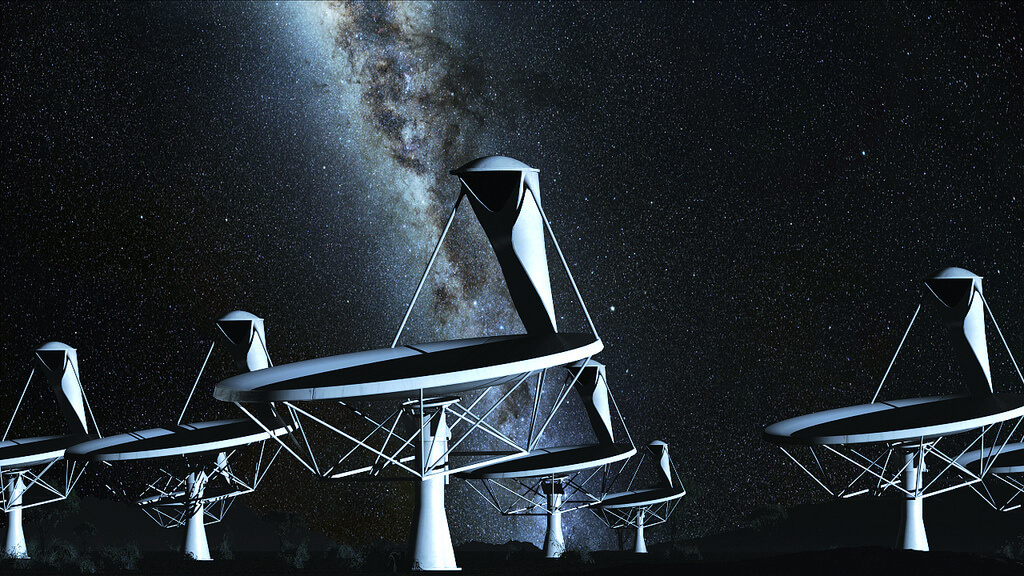As part of a major agreement in the amount of 32.9 million euros, IBM will develop technologies for a radio telescope that will explore the origins of the universe; The new systems will handle twice as much data as the traffic on the entire Internet every day

Researchers at IBM's research laboratories in Zurich and researchers from the Netherlands Institute for Radio Astronomy (ASTRON) will collaborate in a long-term research project to develop and implement a large-scale computing system that will serve the world's largest radio telescope.
IBM and Astron signed an agreement with an initial value of 32.9 million euros, according to which IBM researchers and the Dutch Institute will work in a venture to develop the unique computing systems needed for the project.
The radio telescope antennas that extend over an area of an entire square kilometer and along a strip of 3,000 km - Square Kilometer Array (SKA) - are designed to receive a particularly large amount of signals from deep space. Every day, the telescope's information systems will handle double the volume of information that currently flows for a parallel time on the entire Internet.
Some of the radio signals that will be picked up by the telescope and processed in IBM's systems were created during the Big Bang, which created the universe more than 13 billion years ago - and have been moving through space ever since. Astronomers estimate that analyzing these signals will make it possible to crack the mysteries of dark matter and trace the origin of the universe.
SKA was born as part of an international consortium to build the largest and most sensitive radio telescope in the world. The computing power that will be required to operate this telescope is expected to be equivalent to that of millions of supercomputers, at their powers known to us today.
The first phase of the long-term collaboration with IBM as part of the project will include a five-year project named DOME - similar to the round dome that protects telescopes. As part of this project, IBM experts and the Netherlands Institute for Radio Astronomy will investigate new technologies for computing on extremely large scales, including data transfer, storage processes and real-time data analysis, while streaming them. All of these will be required in order to store and analyze the raw data that will be collected from the telescope's antennas on a daily basis.
Handling these volumes of data requires the use of completely new technologies, including computer chips with a three-dimensional structure that pave the way for significant savings in electricity consumption and reducing the heat emission of the processing components. At the same time, the research will deal with new technologies for internal optical communication between the computer components, and with new generation storage systems, which may also include memory based on technologies to change the path of electrons around the atomic nucleus, in a way that allows storage of bits of information on a single atom.
The researchers will use the methods and tools developed in the IBM research laboratory in Zurich in order to define new computing models and an optimal architecture to handle the huge volumes of data expected to be recorded by the radio telescope.
SKA brings together researchers from more than twenty countries, who plan to build the largest radio telescope in the world, which will use millions of integrated antennas, which will be deployed along a 3,000 km strip across Europe, will offer a reception sensitivity 50 times higher than any existing radio array, and a reception speed of 10,000 times from the current devices.
This new radio telescope will produce several exabytes of data per day for each beam transmitted over one square kilometer. After initial processing, 300-1,500 petabytes of storage will be needed annually. This, compared to about 15 petabytes currently generated annually by the CERN particle accelerator.
Another idea of the magnitude of the technological challenge involved in the project can be obtained if you remember that the 64-bit computing architecture known today is capable of handling an address space of only about 18 exabytes (18.4467441 multiplied by ten to the 19th power).

8 תגובות
Unfathomable numbers.
30 million euros sounds like a small amount of money for the development of such technology.
IBM is doing amazing things.
can you zip it before saving? aka zip in box storewise lol
Maybe they will also pick up signals from other extraterrestrial civilizations....
It doesn't seem to me that they will concentrate only on electron orbits around the nucleus.
With a budget of 32.9 million euros, it is possible to build three spaceships with a diameter of 2 km and a length of 10 km, which will be transported by a ZN42 fusion reactor and will house 50 thousand inhabitants. Why spend on three-dimensional processors with atomic memory and optical communication between the transistors, this is outdated technology.
post Scriptum. A journalist's duck should be cooked on low heat for two hours and then fed to the ducks who are missing here from hunger.
I wonder how much of the information they will pick up with the new radio telescope will be porn.
That does not sound right!
3000 km by 1 km wide, are you sure???
Yes, it's just amazing, I'm really proud of them!!!!!!!!!!!!!!!!!!!!!!!!!!!!!!!!!!!!!!!!!!!!!! !!!!!!!!!!!!!!!!!!!!!!!!!!!!!!!!!!!!!!!!!!!!!!!!!!!!!!! !!!!!!!!!!!!!!!!!!!!!!!!!!!!!!!!!!!!!!!!!!!!!!!!!!!!!!! !!!!!!!!!!!!!!!!!!!!!!!!!!!!!!!!!!!!!!!!!!!!!!!!!!!!!!! !!!!!!!!!!!!!!!!!!!!!!!!!!!!!!!!!!!!!!!!!!!!!!!!!!!!!!! !!!!!!!!!!!!!!!!!!!!!!!!!!!!!!!!!!!!!!!!!!!!!!!!!!!!!!! !!!!!!!!!!!!!!!!!!!!!!!!!!!!!!!!!!!!!!!!!!!!!
Sounds very cool GO GO GO !!!